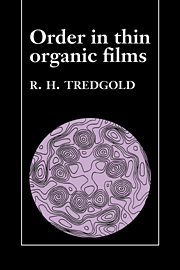Book contents
8 - Biomolecules
Published online by Cambridge University Press: 21 September 2009
Summary
Introduction
The study of order in structures involving biomolecules divides naturally into two parts. On the one hand, one can consider ordered structures in vivo, and on the other hand in man-made systems. The obvious example of thin organic films in the former category is the cell plasma membrane (the term for the exterior membrane of a cell). In 1925 Gorter and Grendel suggested that the cell membrane consisted of a bilayer of lipid molecules with the hydrophilic ends facing outward and the hydrophobic ends facing one another in the interior of the membrane. (The structures of some common lipids are shown in Figure 8.1.) It was a long time before this postulate was definitely confirmed but it is now generally accepted that the plasma membrane is roughly of this general form. The main modifications of this picture are as follows.
(a) Many membrane-bound enzymes penetrate the plasma membrane and are stabilised by the fact that the surface of the enzyme consists of two hydrophilic end regions and an intermediate hydrophobic region. These enzymes take part in the transport of particular substances across the membrane and in various important processes in which energy is stored or interchanged by the medium of ion transport. This topic is returned to below.
(b) A number of glycoproteins are incorporated into the membrane and are involved in cell recognition processes.
[…]
- Type
- Chapter
- Information
- Order in Thin Organic Films , pp. 151 - 169Publisher: Cambridge University PressPrint publication year: 1994



